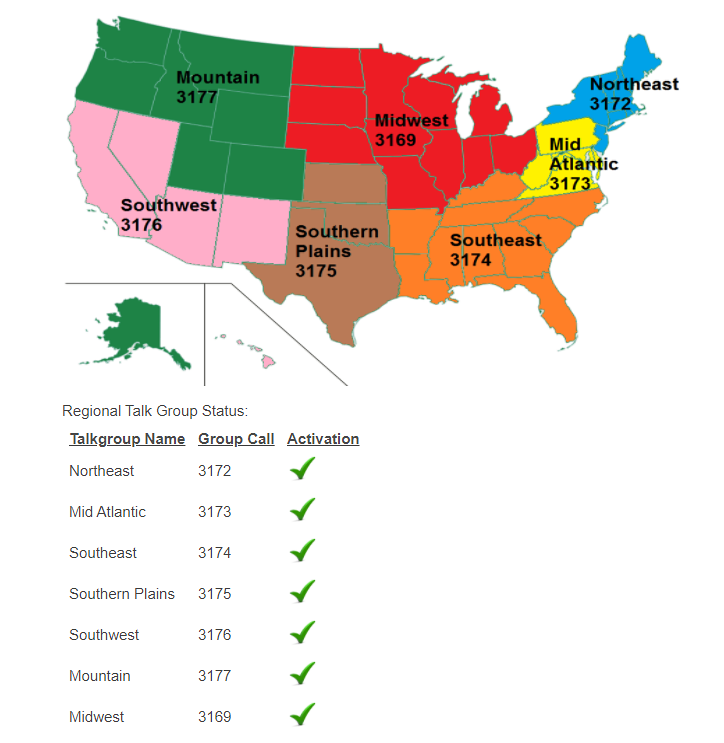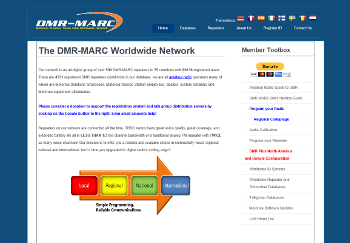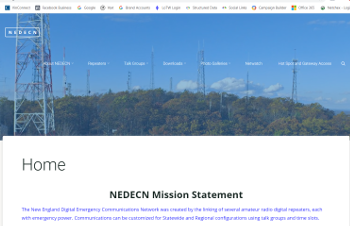Introduction
to
DMR
DMR,
or Digital Mobile Radio,
is an Open Standard digital voice and data mode defined by the European
Telecommunications
Standards Institute (ETSI), and is used in commercial and amateur
products
around the world.
Designed to operate within the existing
12.5 kHz channel spacing used in licensed land mobile frequency bands
globally AND to meet future regulatory requirements for 6.25 kHz
channel equivalence, DMR offers:
- Affordable digital systems
with low complexity.
- Products that are available in
all
regions of the world.
The
DMR protocol covers:
- Unlicensed (Tier I)
- Licensed Conventional (Tier II)
- Licensed Trunked (Tier II)
DMR,
similar to P25 Phase II, both use two-slot TDMA (Time Division Multiple
Access) in a 12.5 kHz channel, while NXDN uses discreet 6.25 kHz
channels using frequency division.
The primary goal of the DMR standard is to
specify a digital system with low complexity, low cost, and
interoperability across brands, so radio communications end users are
not locked into a proprietary solution.
This being said, there are brands which
have not adhered to this open standard and have introduced proprietary
features that make their products incompatible with some networks.
Open
Interfaces,
Open
Standards, and an Open Philosophy.
In
2005, a Memorandum of Understanding was formed with potential DMR
suppliers to establish common standards and interoperability. Although
the standard does not specify it, members agreed to use the half-rate
DVSI Advanced Multi-Band Excitation (AMBE) vocoder to ensure
interoperability.
In 2009, members established the DMR
Association to further advance the standard and to maintain
interoperability.
Formal testing has been taking place since
2010.
DMR and Ham
Radio
- All-digital network of over
400 repeaters in 37 countries.
- More than 10,000 registered
users
- Repeaters are connected ALL
the time.
- Excellent voice quality and
extended battery life.
- Less than 1/3 the channel
bandwidth of analog FM with twice as many voice channels!
- Reliable and scalable choice
in connectivity
Two-Slot
TDMA
DMR
Tier II / Tier II occupies a 12.5 kHz bandwidth with tow
channels sharing using Time-Division Multiple Access (TDMA). This
results in spectrum efficiency of 6.25 kHz per channel.

Comparing
spectrum efficiency of DMR to a wideband FM modulated signal, DMR only
uses 25% of the bandwidth per talk channel. Each channel can carry
either voice or data, depending on the system design. The two time
slots are called Time Slot 1 (TS1) and Time Slot 2 (TS2).
For
the amateur, this means one repeater allows two separate channels at
the same time. Currently, most amateur DMR repeater systems utilize
both channels for voice and some limited text messaging. Typically one
channel (time slot) is used for wide-area and the second is local and
regional talk groups.
Scalable programming. Reliable
communications.
With
DMR, you could choose to operate locally, using simplex, or a repeater
using the Local talk group, which is similar to the way we use
analog repeaters. From there, however, DMR provides many more options
as far as scalability. Choose a Regional talk group for access to
repeaters across several states, a National talk group, to access
repeaters across the country, or even Worldwide!
Regional
Talk
Groups

New
England DMR Talk Groups (Available on most DMR-MARC repeaters in
New England)
Talk
Group Name
Local
Coos Net
Cape Net
Connecticut Statewide (SNE)
Maine Statewide
Massachusetts Statewide
New Hampshire Statewide
Rhode Island Statewide
Vermont Statewide
New England Wide
Region North
NETAC 2
Northeast
North America (NA)
World Wide English (WWE)
World Wide Calling (WW)
TAC 310
TAC 311
TAC 317
SKYWARN
NETAC 1
UA 113
UA 123
Parrot
DMR+ USA (Dongle Access)
DMR+ UK (Dongle
Access)
DMR+ Pacific (Dongle
Access)
|
ID
9
8803
8804
3109
3123
3125
3133
3144
3150
3181
8
8802
3172
3
13
1
310
311
317
759
8801
113
123
9998
133
143
153
|
Description
Local - Single Site Only
Coos County, NH
Cape Cod, MA
Connecticut, Eastern LI, NY QSOs
Maine QSOs
Massachusetts QSOs
New Hampshire QSOs
Rhode Island QSOs
Vermont QSOs
New England Wide + NB
Northern New England
New England TAC 2
New England + NY, NJ & PA
North America (U.S. & Canada)
World Wide English
World Wide (All Languages)
TAC 310
TAC 311
TAC 317
SKYWARN Activations and Nets
New England TAC 1
User Activated English 1
User Activated English 2
Listen to your own audio
DMR+ USA
DMR + UK
DMR + Pacific |
Time
Slot
TS2
TS2
TS2
TS2
TS2
TS2
TS2
TS2
TS2
TS2
TS2
TS2
TS1
TS1
TS1
TS1
TS1
TS1
TS1
TS1
TS1
TS1
TS1
TS1
TS1
TS1
TS1 |
|
Click here
for a list of NEDECN Talk Groups
Brandmeister Talk Groups (Available via Hotspots and some
repeaters)
Talk
Group Name
Local
Local
Region
World Wide
Europe
North America
Romania
Connecticut Statewide
Maine Statewide
Massachusetts Statewide
New Hampshire Statewide
Rhode Island Statewide
Vermont Statewide
Northeast
TAC 310
TAC 311
WW TAC 1
WW TAC 2
WW TAC 3
English
SOTA
POTA
America Link
Berkshires
|
ID
1
9
8
91
92
93
226
3109
3123
3125
3133
3144
3150
3172
310
311
901
902
903
913
973
3181
31656
31252
|
Description
Local - Single Site Only
Local - Single Site Only
Regional
World Wide
Europe
North America
Romania
Connecticut QSOs
Maine QSOs
Massachusetts QSOs
New Hampshire QSOs
Rhode Island QSOs
Vermont QSOs
Northeast QSOs
TAC 310 (Not a Call Channel)
TAC 311
Worldwide TAC 1
Worldwide TAC 2
Worldwide TAC 3
English
Summits on the Air
Parks on the Air
America Link
Berkshires
|
Time
Slot
TS1
TS1
TS1
TS1
TS1
TS1
TS1
TS1
TS1
TS1
TS1
TS1
TS1
TS1
TS1
TS1
TS1
TS1
TS1
TS1
TS1
TS1
TS1
TS1
|
|
Click
here for a list of
Brandmeister Talk Groups
Time slots
may vary depending on local repeater preferences
Digital Voice -
The Basics
Almost
all of us use
DV mode virtually every day of our lives. In fact, to many, it is their
life! Mobile phones use advanced digital voice modes and the older 2G
networks use a version of TDMA very similar to our own. All digital
voice standards use encode/decode software called "codecs," which can
be proprietary, as in the case of D-STAR, or open source, as in the
case of DMR. DMR uses a form of FSK or "frequency shift keying" known
as C4FM four level FSK constant envelope modulation. The voice is
encoded/modulated, transmitted as a stream of data, then decoded by the
receiver. The advantages of DV include easy IP distribution, excellent
bandwidth efficiency and high quality audio. DMR applies a channel
access protocol known as "Time Division Multiple Access" to allow two
timeslots or voice channels within a single 12.5 kHz frequency
allocation. Conveniently, the timing alogorithm for this is controlled
by the repeater but the latest Motorola radios such as the 4000 series
can also provide the facility - Timeslots
and Talkgropus - Issue 2 February 2014 - Newsletter of DMR-UK &
Yorkshire DMR Group.
First Steps
–
Registration
Go
to the DMR-MARC website and follow the
on-screen instructions.
Although it says “User” registration, it
is possible to have more than one ID, (but this is not recommended).
A
mobile and a base station, for example,
could have the same ID as long as they are not transmitting on the same
Time Slot and Talk Group at the same time. This
is also where you would register a repeater on the DMR network.
Next:
Get a Radio!
Manufacturers include: Hytera, Motorola,
Kenwood, Vertex Standard,
Icom, Connect Systems, Tytera, and more!
Click
here to download a code plug
for the Connect Systems CS801 (WS1EC channels)
Click
here to download the
programming chart for the Connect Systems CS801 (WS1EC channels)
Click
here to download a code plug for the Connect Systems CS800D (dual
band mobile)
For More Information:

DMR MARC Worldwide Network |

New England Digital Emergency Communications Network |
DMR
Repeaters
(Maine, New Hampshire, and Vermont)
Click
here for the most current repeater listing, and to find out
more about
new repeater sites.
NEDECN DMR Nets
Here's a list of some of the nets that take place on various Talk
Groups around New England:
- Sundays at 10 AM is the Maine Dirigo Net on ME Statewide TG
(3123)
- Sundays at 8 – 9 PM is the Providence Radio Association (PRA) Net
on NETAC1 TG (8801)
- Mondays at 7:30 –
8:00 PM is the New England Digital
Swap Net on New England Wide TG (3181).
- Mondays at 8 – 9 PM is the New England DMR Net on New England
Wide TG (3181).
- Tuesdays at 8 – 9 PM is the Vermont State DMR Net on VT
Statewide TG (3150)
- Wednesdays at 8 – 9 PM is the YCCC Contesting and DX Net on NETAC1
TG (8801)
- Thursdays at 8 – 9 PM is the New Hampshire State DMR Net on NH
Statewide TG (3133)
- Thursdays at 7:30 –
8 PM is the New England SKYWARN DMR
Net on the SKYWARN TG (759)
SKYWARN
Activations–
The National Weather Service in Gray, ME will make call-ups for
weather reports on the SKYWARN TG (759). Please call in with your
observations during significant weather events. In the event of
weather activations by multiple weather offices (Gray, Norton,
Burlington or Albany) , communications will shift to
Statewide Talk Groups as appropriate (ME, NH, MA, RI, VT, etc.).
DMR Simplex Sunday
On
Sunday, June 17, 2018, WSSM members set out on a coordinated mountain
topping expedition in order to learn more about the range limits of DMR
simplex. The longest distance contact achieved was between Mt.
Equinox, VT and Saint-Jean-Sur-Richelieu, QC - a distance of: 151.13 mi / 243.22
km (UHF), and the second longest was between Mt. Greylock, MA and Mt.
Washington, NH - a distance of: 145.56
mi / 234.25 km (both VHF and UHF).
Click
here to read the whole story.
|